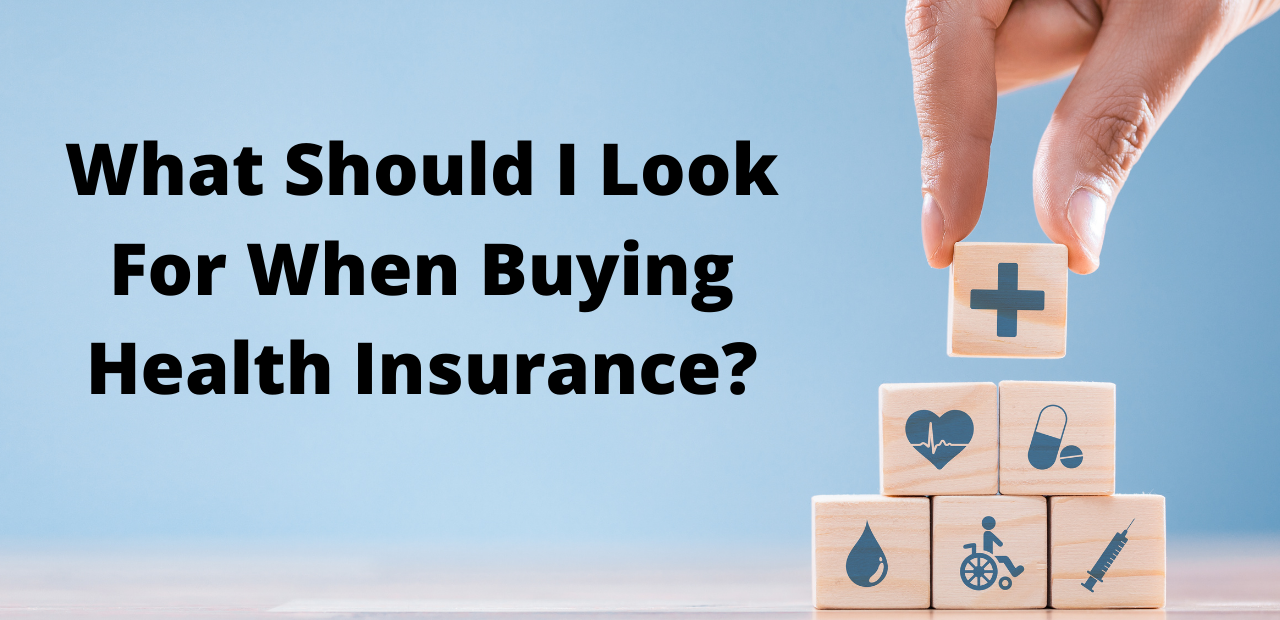What should I look for when buying health insurance?

Just the Essentials…
- Unless you qualify for a Special Enrollment Period, you can only choose or change your plan during the Open Enrollment Period.
- All health insurance plans have a network of affiliated providers: your insurance may not cover it if you wish to visit an out-of-network provider. Check to make sure your preferred doctor is in-network before applying.
- The different medal rankings (Bronze, Silver, Gold, and Platinum) indicate how much of your healthcare costs you will be required to pay out of pocket. While a Platinum plan has a lower deductible and out-of-pocket maximum, you will have to pay a higher premium to compensate.
- Tax benefits and cost-sharing reductions may result in higher-tier plans (like Silver) being less expensive than their lower-tier counterparts (Bronze and Catastrophic).
- It is essential to consider all aspects of a healthcare plan to find the right one for you.
The Ins and Outs of Health Insurance
Buying health insurance can be a challenge. Once you log in to the Marketplace, it’s easy to quickly feel overwhelmed by information. What’s the difference between a Bronze and Platinum plan? Why does this Platinum plan only have three stars while this Silver one has five? What’s the difference between an HMO and PPO?
Sorting through the options becomes easier once you understand the jargon. Here’s what to look for when buying health insurance.
What is Open Enrollment?
Each year, the Health Insurance Marketplace holds an Open Enrollment Period (OEP), during which anyone is free to sign up for or modify their insurance coverage.
For most Americans, the OEP is from the first whole work week of November to the first full work week of January. However, some states have OEPs which may differ from this norm. If your state has its own Marketplace, be sure to check for the exact dates on its official website.
Outside of the OEP, your options are typically limited. While you can change your plan freely during the OEP, you’re committed to a full year of coverage once it ends. However, there are times where you may be eligible for a Special Enrollment Period (SEP) due to significant life changes, such as loss of employment, the birth of a child, or an address change. During this time, you have 60 days to apply for coverage, after which you will need to wait until the next OEP to apply.
This time limit can add a lot of stress to the process. In a best-case scenario, you’ll have only a few months to commit to an insurer for an entire year. That makes finding the right plan all the more critical.
How do I go about comparing plans?
Healthcare plans on the Marketplace have a few essential metrics you’ll need to consider before committing to one. These include, but are not limited to:
- Plan Type: What providers are available under your plan, and how much out of network coverage is provided.
- Cost-Sharing: How much of your medical care is covered by insurance, and what you need to pay out of pocket.
- Star Rating: A rating provided by the government, which indicates customer satisfaction and overall quality of care.
Knowing the difference between these categories is key to selecting the right plan for you.
At the most basic level, insurance is about sharing risk. You contribute a regular payment, called a premium, to a shared fund. When you or any other contributor suffers from a medical emergency, money is withdrawn from the fund and used to pay for care. Therefore, the financial risk of one person suffering a medical emergency can be shared across thousands of people.
However, things aren’t always quite that simple. Insurers and healthcare providers are in constant negotiations, which can seriously affect the cost and coverage of your plan.

What are the different plan types?
Insurance companies often attempt to reduce their risk further by negotiating discounted rates with hospitals, doctors, and pharmacies. The insurer directs clients to these Healthcare providers, who agree to charge lower fees in turn. The providers who offer these discounted rates make up the insurer’s network.
Going to an in-network provider is great for both you and your insurer, as you both pay less overall. That’s why, regardless of your plan, insurers will recommend you visit doctors in-network. However, different plans have different rules when it comes to out-of-network providers.
Currently, there are four types of plans on the Marketplace, which differ in how they interact with out-of-network providers.
- Exclusive Provider Organization (EPO): As the name implies, this type of plan limits you to network providers, except in emergencies. They tend to cost less than other plans, but the network restriction can sometimes be inconvenient.
- Health Maintenance Organization (HMO): This type of plan is similar to an EPO in that it does not cover out-of-network services except in an emergency. However, it differs in that it covers more preventative care, focusing on keeping you from getting sick in the hopes of reducing future risk. These plans are prevalent and suitable for those without preexisting conditions. However, they can also suffer many of the same restrictions as an EPO.
- Point of Service (POS): This type of plan allows you to use out-of-network providers, though you will be charged less if you stay in the network. However, you will need to get a referral to see a specialist. These plans are typically more expensive than HMOs, but the flexibility can be enticing to those who wish to have more freedom of choice in healthcare providers.
- Preferred Provider Organization (PPO): The most flexible type of plan available, a PPO plan allows beneficiaries to go to any provider they so choose. However, additional fees may arise if you choose to see an out-of-network provider without a referral. This type of plan is ideal for people who travel a lot, but can often be more expensive.
Before selecting a plan, it’s essential to confirm that your preferred provider is in-network. If they’re not covered, you should consider selecting a different plan. Some people even choose more expensive, flexible plans to maintain a relationship with their family doctor.
How does insurance cost sharing work?
Another factor that affects your plan choice is the amount of coverage you will receive. Typically, the more money you put toward your insurance plan, the more you can take out when you need it.
Put another way, your insurance may not always cover 100% of your healthcare costs. In this event, you are responsible for a portion of all healthcare expenses, which depends on your plan. This system is referred to as cost-sharing. Insurers and beneficiaries share costs in three different ways:
- Deductible: This is the amount of money you need to pay before your plan begins to pay for covered services. In essence, a deductible is a promise that you will cover a certain number of services out-of-pocket while still contributing to the collective fund.
- Coinsurance: After you meet your deductible, your plan may still not cover 100% of your healthcare expenses. Instead, it will pay a portion of them, leaving the rest for you to pay. This uncovered portion of your expenses is called coinsurance. Think of it like a second deductible of sorts: while your insurance covers most of the cost, you agree to pay a certain percentage, up to your out-of-pocket maximum. Once you hit that maximum, you’ll only need to pay for services your insurance doesn’t cover. Everything else will be billed to your insurer.
- Co-payment or Copays: Whenever you consult a doctor, either for a routine check-up or for a specialist opinion, you’ll be charged a copay. This is the amount of the doctor’s fee that is not covered by your insurance. Unlike coinsurance, your copay is unaffected by your deductible: your insurer will cover the cost of the visit no matter what. In exchange, the money spent on copays does not go toward your deductible but does go toward your out-of-pocket maximum.
As a rule, the higher your premium, the less you need to put toward cost-sharing. Deductibles, copays, and out-of-pocket maximums are all lower.
What is the health insurance Marketplace medal system?
To help you tell the difference between plans, the Marketplace uses a medal system, ranging from Bronze to Platinum, which indicates the amount of cost-sharing you should expect in a given plan. Bronze plans are usually the most affordable, but may also have very high deductibles and out-of-pocket maximums. Platinum plans typically have higher premiums, but low or even no deductible.
Those under 30 or who have a special hardship exemption can also go below Bronze, purchasing a catastrophic plan that covers the bare minimum: three doctor visits a year with a very high deductible, in exchange for very low premiums.
When you buy a lower-tier plan, you’re essentially taking a gamble that you don’t expect to suffer a medical emergency that year. Choosing a bronze or catastrophic plan can be a risky proposition, but if you’re healthy and have no preexisting conditions, it can be a good way of saving money.
Also, most plans, even catastrophic ones, cover preventative care at no cost to you.
What are star ratings?
One crucial factor for any plan is the quality of care, which is measured in three metrics:
- Member experience: A general review of patient satisfaction, including ease of getting appointments and perception of care.
- Medical care: A more objective measure of the quality of care, based on how well your plan can help you manage conditions and provide preventative services.
- Plan administration: How well the plan is run, including transparency and customer service.
Note that a plan without stars does not necessarily mean it’s a bad plan: it may be a new plan or not have enough enrollees for an adequate sample. If a plan meets your needs, it may be worth looking into even despite its lack of a star rating.
It’s important to note that unlike plan type and medal rating, a plan’s star rating has no bearing on its cost. A plan with a higher star rating may be less expensive than one with a lower star rating. Also, there is no guarantee that a five-star plan will be available in your area, so don’t fret if the only options you have are three or four-star plans.
What’s covered under health insurance Marketplace plans?
If money isn’t an object, a five-star platinum plan may seem like the best option available, but that’s not necessarily the case. A plan can have an excellent rating and zero deductible, but it can still leave gaps in coverage that can leave you paying for essential services out of pocket.
All plans on the Marketplace cover a set of essential benefits, including hospital visits, mental health services, and maternity care. However, dental and vision coverage for adults is not considered essential and is not covered by most plans. While you can purchase separate dental coverage in the Marketplace as an add-on, stand-alone vision insurance is only offered by third parties and is not subject to Marketplace regulations.
In addition, specific plans may offer specialized management programs for conditions such as diabetes or obesity. While insurance plans cannot reject you for a pre-existing condition, they may not provide the care you need to treat that condition, which can make them a less than ideal choice for your needs.
Plans may also have different coverage areas: while an insurance network isn’t necessarily bound to a geographic location, HMOs and EPOs may only offer coverage in certain areas. Be wary if you expect to spend a significant amount of time away from your primary address.

What does it all cost?
It may seem like most of these factors directly correlate with the plan’s cost: a PPO is more expensive than an EPO, a Gold plan is cheaper than Platinum, and a plan with dental and vision coverage probably costs more than one without. While this is generally true, nothing is ever quite that simple.
First, there’s the matter of the premium tax credit: this is a government subsidy that goes toward your monthly premium when you purchase through the Marketplace. Your household income determines the exact level of your tax credit, and the precise thresholds for qualifying depend on your state. However, these credits can also make an expensive plan much more affordable and may even cover your premiums entirely. It is important to note that you cannot apply a premium tax credit to a catastrophic plan. If you qualify for a catastrophic plan and a decent premium tax credit, a Bronze or Silver plan may end up being a considerably more affordable option.
Silver plans also have the unique privilege of being eligible for cost-sharing reductions, which lower your deductible and out-of-pocket maximum. These extra savings can result in Silver plans that cost considerably less than their Bronze equivalents while providing more coverage.
Finally, if you enroll in a High Deductible Health Plan (HDHP), you may be eligible to open a Health Savings Account (HSA). This untaxed savings account allows you to contribute a set amount of money per year toward future medical care. This money is yours. Your HSA’s balance rolls over from year to year, and you can never lose access to it. Even if you switch to a plan that no longer qualifies for an HSA, you simply lose the ability to deposit money into that account. With an HSA, you can still withdraw money for medical expenses as you need it and even invest it in the stock market.
You’re never required to use your HSA for medical expenses either: if you still have a balance by the time you turn 65, it transforms into a pseudo-retirement account. This means that you can freely cash out at any time after retirement, although you will still owe taxes unless you use the funds on medical expenses.
In some cases, you can withdraw from an HSA before you turn 65, but you will owe a 20% penalty in addition to taxes. If you’re not anticipating a dire need for emergency medical coverage, it may be worth it to deliberately enroll in an HDHP to take advantage of the HSA’s tax benefits.
Finding the right health insurance plan for you is all about weighing your options. There is no such thing as a one-size-fits-all plan; you need to research and find which option fits your needs. Luckily, we can help you compare the plans available in your area. Enter your zip code below to compare top insurance providers’ plans today.
Key Resources:
What is the Open Enrollment Period?
What is a Special Enrollment Period?
Choosing a Plan: Your Total Costs
Choosing a Plan: Plan Categories
Hardship Exemptions for Health Insurance Coverage Costs
What is a Catastrophic Health Plan?
How Can I Get Preventive Care Benefits?
What Do Marketplace Plans Cover?
How Can I Get Mental Health and Substance Abuse Coverage?
How Can I get Coverage for Pre-Existing Conditions?
What is the Premium Tax Credit?
What is Cost-Sharing Reduction?
Understanding High Deductible Health Insurance Plans
